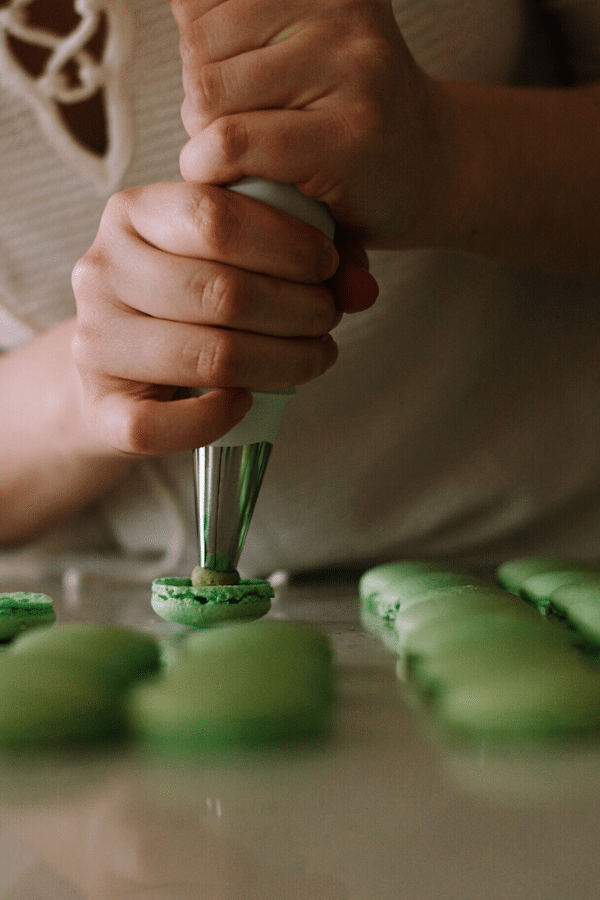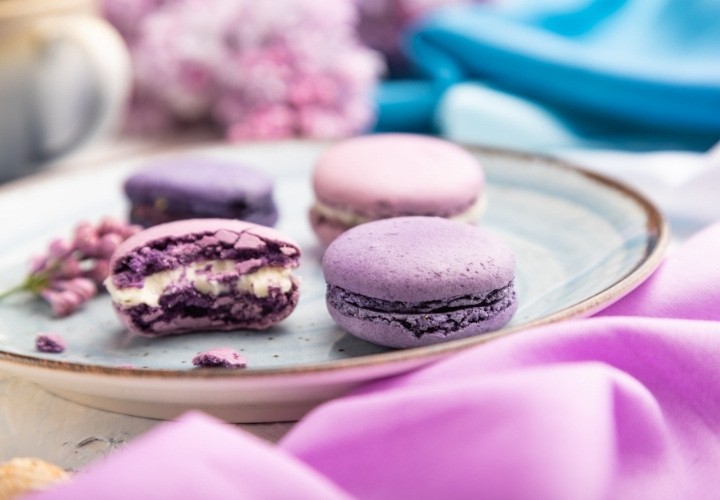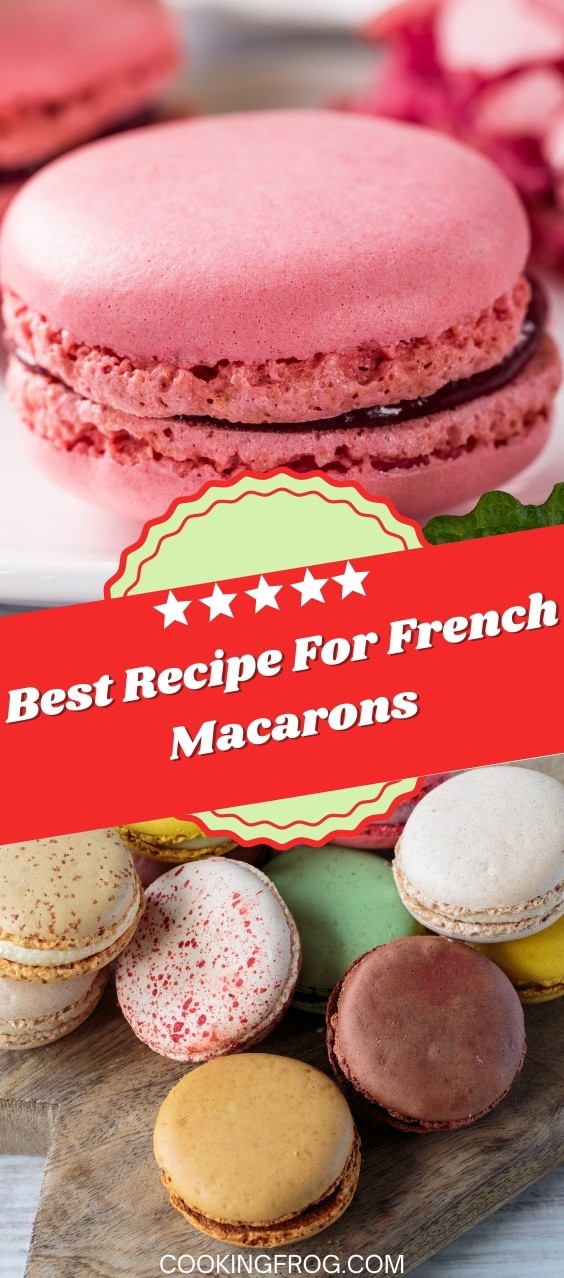Meringue-like, Light, airy, and delicious this recipe for French macarons have already been on my baking bucket list for a couple of years. I’ve been learning, testing, and driving myself mad in my kitchen for months, hoping to get these perfect. I’ve never been more passionate about any recipe like this one, and with perseverance, there must come success. And it did!
French macarons are very fine and delicate cookies with a crunch outside and a soft interior. They’re nougat-like, with a chewy texture, and could be filled up with anything from salted caramel and frosting to chocolate ganache and lemon curd.
If there’s one very important factor to understand before you begin with French macarons in the home, it’s this: these cookies aren’t simple. Impossible? Don’t also be afraid, they just require patience and a little practice.
Ingredients
For the Macaron Shells
-
3 large egg whites (about 3.5 oz / 100g), room temperature
-
1 ½ cups (5 oz / 140g) almond flour, finely ground
-
1 cup (4.5 oz / 128g) powdered sugar
-
3 Tbsp (3.1 oz / 90g) granulated sugar
-
¼ tsp cream of tartar
-
1 tsp vanilla extract
-
Food coloring (optional)
For the French Buttercream
-
1 cup (225g) unsalted butter, softened
-
5 egg yolks
-
½ cup (100g) granulated sugar
-
3 Tbsp water
-
1 tsp vanilla extract
-
Pinch of salt
-
Food coloring (optional)
Instructions
Step 1: Prepare the Macaron Shells
-
Sift almond flour and powdered sugar together into a large bowl. This helps create smooth, delicate shells.
-
In a clean, grease-free mixing bowl, beat the egg whites on medium speed until foamy. Add cream of tartar.
-
Slowly add the granulated sugar while beating, then increase to medium-high speed. Beat until stiff, glossy peaks form.
-
Add vanilla (and food coloring, if using) and mix just until incorporated.
-
Using a spatula, fold in ⅓ of the almond flour mixture. Then gently fold in the rest in two additions. The batter should flow like “lava” and be able to form a figure 8 when dropped from a spatula without breaking.
Step 2: Pipe & Rest
-
Transfer the batter into a piping bag fitted with a round tip. Pipe 1-inch rounds onto a parchment-lined baking sheet. Dab a little batter under the parchment corners to keep it in place.
-
Tap the tray firmly on the counter a few times to release air bubbles. Use a toothpick to pop any that rise to the surface.
-
Let the shells rest at room temperature for 30–40 minutes, until the tops form a skin and no batter sticks to your finger when lightly touched.
Step 3: Bake
-
Preheat oven to 300°F (150°C).
-
Bake shells for 13–15 minutes, rotating the tray halfway through. They’re done when they don’t jiggle if touched lightly.
-
Cool completely before removing from the parchment.
Step 4: Make the French Buttercream
-
Combine sugar and water in a small saucepan over medium heat. Cook until it reaches 235–240°F (soft-ball stage).
-
While the syrup cooks, beat the egg yolks in a stand mixer until thick and pale.
-
With the mixer on low speed, carefully drizzle the hot syrup into the yolks in a thin stream. Increase speed and whip until the mixture cools to room temperature.
-
Add the butter, one cube at a time, until fully incorporated and creamy. Mix in vanilla, salt, and optional coloring.
Step 5: Assemble
-
Pair macaron shells of similar size. Pipe buttercream onto the flat side of one shell and sandwich with another.
-
Place filled macarons in an airtight container and refrigerate for at least 24 hours (ideally 48–72 hours). This “matures” them, letting the filling soften the shells for the perfect chewy texture.
Storage & Make-Ahead Tips
-
Refrigerate: Store in an airtight container in the fridge for up to 5 days.
-
Freeze: Macaron shells (unfilled) can be frozen for up to 2 months. Thaw at room temperature, then fill.
-
Make-Ahead: Buttercream can be made 3 days in advance and kept refrigerated. Bring to room temperature and re-whip before using.
Why are Macarons So Hard to Bake?
Macarons can be very tricky to bake. Any of a 1000’s factors can impact how your macarons will turn out. Many home cooks often lament on how there has to be|there should be something very wrong with the recipe they’re using and are always searching for a mysterious recipe that will yield perfect macarons.
In all honesty, the majority of the items on the ingredient lists for the macaron are much like each other because a specific ratio of every (but few) ingredient is required for their composition. You need to notice if you are mastering the important methods at every step of baking these little desserts, including the mixing of the batter and how to utilize your kitchen oven among others.
Will My Macarons Be Perfect?
In my own recipe are all the stuff I’ve learned from my very own macaron baking adventure within my home kitchen. I will I let you know that, without any doubt, you may also perfect wonderful macarons in the event that you} practice a whole lot – with the proper techniques of course.
I don’t believe there’s a magic recipe available, including mine! What’s important is knowing the appropriate techniques and then tweaking them using what is most effective in your kitchen. Listed below are the building blocks and techniques you’ll need. Start with following every step carefully and practice! Best of luck my friends!

BEST TIPS FOR MAKING this MACARON Recipe
- MERINGUE!! The meringue needs to be stiff. I didn’t know that French meringue might be whipped to this kind of thick marshmallowy consistency but all it requires a little bit of extra whisking. You’ll spot the meringue begin to fill the whisk when you’re getting near the right stage.
- Egg whites! Divide the eggs, put the whites in a clean glass, cover with plastic wrap and let them spend time in the refrigerator, for a couple of days before using. This process will dehydrate them and make sure they are ideal for macarons.
- SIFT! Those bigger bits of almond flour will mar the surface of your macarons. The best way would be to sift, whiz in the food processor, and repeat 2 more times. Discard the bigger particles, don’t attempt to push them through the sieve.
- The mixing will require some practice, you’ll fold the batter and then utilize the spatula to really gently press the batter against the bowl. You wish to remove a few of the bubbles but never to much. Keep on doing this until it reaches a thick consistency like “lava”. It will slowly fall off the spatula in ribbons and manage to form a figure eight without breaking.
- Pipe the macarons at the right angle to the surface. If your tip is pointing somewhat in any particular direction once you pipe the macarons could be oblong or malformed.
- Add the color to the meringue when it reaches the soft peak stage.
- If you are finishing the piping motion, stop with the squeezing and pull up with a round motion.
- The macarons are best after 2 or 3 days of resting in the refrigerator.
- In the event that you over-bake the shells and they’re too crispy, brush them underneath with some milk before assembling, to soften them up.
Macaronage
Once you fold that Stiff meringue using the almond and sugar mixture, it will begin looking really rough but as you continue folding if will end up silkier and start to flow off the spatula in a thick, slow and steady drizzle.
It is additionally vital to deflate SOME of the bubbles in the mixture in order to gently swipe the spatula over the surface of the batter to simply help remove some of them.
Some macaron recipes offer you a specific amount of folds but I’ve discovered that you really should fold and smooth the batter until it lets you know when to stop. If it’s a big humidity or the temp is warm or cold that day your macaronage is likely to be affected.
After your batter reaches the required stage you’ll notice it become shiny and gently fall off the spatula in a ribbon that will form a “8” figure without breaking. Once you press the batter air bubbles won’t be present, at least the big ones.
French Macaron Filling
I’ve prepared a batch of creamy, French buttercream using my remaining egg yolks to fill my macarons, but you could use any filling you prefer! You can try it with US buttercream or Italian buttercream, a whipped ganache, or a disk of ice cream!
Are macarons from France?
While macarons are pretty much connected with France, they’re actually considered to have been moved from Italy to France by the chef of Catherine de Medici, queen of France in the late 16th century.
What’s a French macaron?
A macaron is really a delicates meringue-based cookie sandwich made basically from almond four, egg whites, and sugar. The surface is crisp but inside they’re more chewy and moist. They could be filled up with a ganache, buttercream or anything you like!
What’s the difference between a macaron and a macaroon?
- A macaroon is simply a combination of sweetened coconut flakes, eggs, and sugar. Tasty but not to light!
- Macarons are really a light meringue-based cookies with a layer of piped buttercream or ganache in the center.
- Both names are spelled and sound almost the same nevertheless, the treats are very different!





Thank you! These instructions were very straight forward and made a lot of sense. Our macarons came out beautifully! We dyed them yellow and used your recipe to make a lemon French buttercream to fill them with. Yum!
You are welcome, i’m glad you’ve liked it.
What a fantastic recipe! I used pistachio paste instead of vanilla and it turned out great! And no more left-over egg yolks! 🙂
Thanks!
Veronika
Hey Veronica, I’m so happy these Macarons turned out great for you. Thanks for the pistachio paste tip, and thanks for your support! 🙂